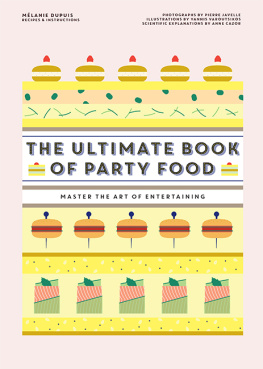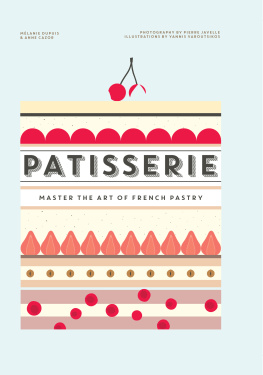FOR MARIE & MILAN
CONTENTS HOW TO USE THIS BOOK
BASICS Discover all the basic recipes and principles used by caterers, categorised into pastries and doughs, pancakes, bread, sauces, creams and ballotines, with practical advice for getting organised. Each recipe comes with an infographic and an explanation of how to prepare the dish.
RECIPES Put the basics to use and make kebabs, mini choux pastries, vol-au-vents, little soups and miniature desserts. Each recipe cross-references the necessary basics and comes with an infographic for understanding the concept of the recipe, and step-by-step photos that guide you through the preparation.
Each recipe is accompanied by a small symbol indicating, at a glance, if the dish is to be served hot or cold.
GLOSSARY Find tips and deepen your knowledge of basic cooking techniques, and products, accompanied by illustrations.
There are also detailed sample menus to suit any cocktail party.
HOW DO THE LAYERS CREATE THE FLAKINESS?
Layering the butter and dough traps the water in the pastry, which evaporates as steam during cooking, but cant escape. Its this steam that makes each layer of pastry swell up. WHAT DOES THE VINEGAR DO?
It makes the pastry slightly acidic, which helps it keep for longer. WHY DOES THE DOUGH HAVE TO BE RESTED?
When the water is mixed with the flour, it makes the starch grains swell up. The added butter slips between the swollen starch grains, and the flour proteins form a gluten network. During the resting time, this gluten network which becomes very stretched when the pastry is worked will relax and give the pastry a less firm texture. MAKES 560 G 1 DOUGH 120 g water 10 g white vinegar 5 g salt 30 g unsalted butter, melted 250 g (1 cups) plain flour 2 FOR TURNING 150 g unsalted butter
To make the dough, mix the water, vinegar, salt, butter and flour in the bowl of a stand mixer fitted with the dough hook attachment. Mix at low speed until the mixture is smooth.
Roll into a ball, wrap in plastic wrap and refrigerate for at least 2 hours. Put the butter between two sheets of baking paper. Tap lightly with a rolling pin to make a 10 cm square about 1 cm thick. Refrigerate for 30 minutes. Rest the dough at room temperature for 30 minutes. into a cross-like flattened diamond shape, leaving it slightly thicker in the centre.
Place the butter in the middle. Rest for a few minutes at room temperature, then fold the four corners into the middle, taking care to maintain the same thickness all over. The butter should be firmly enclosed in the dough. Roll the pastry out away from you, as evenly as possible, into a rectangle measuring about 30 cm 15 cm. Fold the pastry into a wallet: fold the bottom third towards the middle, then fold the top third over it. Then make an anti-clockwise quarter (90-degree) turn with the folded pastry (with the seam at the right).
You have made the first simple turn. To make the second turn, roll out the pastry away from you. Fold it into a wallet again and make an anticlockwise quarter turn. Wrap in plastic wrap and rest in the refrigerator for at least 4 hours, ideally overnight. Make two more simple turns, then rest in the refrigerator for a further 34 hours. Make one or, at most, two more turns before using.
You can create gentle indentations with your fingers to indicate the number of turns you have completed.
WHY DO YOU REST THE PASTRY?
Refrigerating the pastry allows the butter to harden. The gluten network continues to form through oxidation, which means the pastry will retain its shape better during cooking. ORGANISATION 3 months before | Make the dough and freeze it, uncooked, in an airtight container. OR 3 days before | Make the dough and store it the same way in the refrigerator. 1 day before | Defrost the dough in the refrigerator.
MAKES 240 G
(FILLS 1 25 CM TART TIN) 125 g plain flour 2 g salt 20 g poppy seeds 60 g ( cup) unsalted butter, chilled and cut into small cubes 5 g white vinegar 30 g water Place the flour, salt, poppy seeds and butter in the bowl of a stand mixer fitted with the whisk attachment.
MAKES 240 G
(FILLS 1 25 CM TART TIN) 125 g plain flour 2 g salt 20 g poppy seeds 60 g ( cup) unsalted butter, chilled and cut into small cubes 5 g white vinegar 30 g water Place the flour, salt, poppy seeds and butter in the bowl of a stand mixer fitted with the whisk attachment.
Mix at low speed until the mixture resembles breadcrumbs. Add the vinegar and most of the water, then mix on low speed until a smooth dough forms, adding more water as needed. Turn the dough out onto a lightly floured surface and it once or twice to ensure the dough is smooth. Flatten the dough to a thickness of 23 cm. Cover with plastic wrap and refrigerate for at least 2 hours.
WHY IS CRACKER DOUGH SO CRUMBLY?
It is made with butter and flour, flavoured with cheese.WHY IS CRACKER DOUGH SO CRUMBLY? It is made with butter and flour, flavoured with cheese.
Once these are mixed, the dough becomes very dry. The lack of water prevents the ingredients from sticking together this makes the dough crumbly. ORGANISATION 1 month before | Make the dough and freeze, uncooked, in a 5 mm thick sheet, or already cut and sealed in an airtight container. OR 3 hours before | Make the dough and refrigerate uncooked. OR 2 hours before | Make the dough and set aside to rest for 2 hours.
























